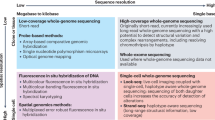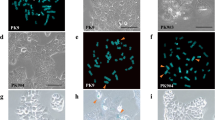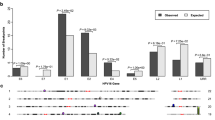Abstract
The p53 gene codes for a nuclear protein that has an important role in normal cellular replication1–4. The concentration of p53 protein is frequently elevated in transformed cells1,2. Transfection studies show that the p53 gene, in collaboration with the activated ras oncogene, can transform cells5–7. Chromosomal localization may provide a better understanding of the relationship of p53 to other human cellular genes and of its possible role in malignancies associated with specific chromosomal rearrangements. A recent study mapped the human p53 gene to the long arm of chromosome. 17 (17q21–q22) using in situ chromosomal hybridization8. Here, by Southern filter hybridization of DNAs from human–rodent hybrids, we have localized the p53 gene to the short arm of human chromosome 17.
This is a preview of subscription content, access via your institution
Access options
Subscribe to this journal
Receive 51 print issues and online access
$199.00 per year
only $3.90 per issue
Buy this article
- Purchase on Springer Link
- Instant access to full article PDF
Prices may be subject to local taxes which are calculated during checkout
Similar content being viewed by others
References
Crawford, L. V. Int. Rev. exp. Path. 25, 1–50 (1983).
Rotter, V. & Wolf, D. Adv. Cancer Res. 43, 113–140 (1985).
Milner, J. & Milner, S. Virology 112, 785–788 (1981).
Reich, N. C. & Levine, A. J. Nature 308, 199–201 (1984).
Parada, L. F., Land, H. A., Weinberg, R. A., Wolf, D. & Rotter, V. Nature 312, 649–651 (1984).
Eliyahu, D., Roz, A., Gruss, P., Givol, D. & Oren, M. Nature 312, 646–649 (1984).
Jenkins, J., Rudge, K. & Currie, G. Nature 312, 651–653 (1984).
Le Beau, M. M., Westbrook, C. A., Diaz, M. O., Rowley, J. D. & Oren, M. Nature 316, 826–828 (1985).
Taggert, R. T., Mohandas, T., Shows, T. B. & Bell, G. I. Proc. natn. Acad. Sci. U.S.A. 82, 6240–4244 (1985).
Mohandas, T. et al. Am. J. hum. Genet. 31, 586–600 (1979).
Meerakhan, P. & Smith, M. Cytogenet. Cell Genet. 37, 71–102 (1984).
Mitelman, F. Progress and Topics in Cytogenetics Vol. 5 (ed. Sandberg, A. A.) 1–722 (Liss, New York, 1985).
Benchimol, S. et al. Somat. Cell molec. Genet. 11, 505–509 (1985).
Wolf, D., Laver-Rudich, Z. & Rotter, V. Molec. cell. Biol. 5, 1887–1893 (1985).
Wahl, G., Stern, M. & Stark, G. Proc. natn. Acad. Sci. U.S.A. 76, 3683–3688 (1979).
Author information
Authors and Affiliations
Rights and permissions
About this article
Cite this article
Miller, C., Mohandas, T., Wolf, D. et al. Human p53 gene localized to short arm of chromosome 17. Nature 319, 783–784 (1986). https://doi.org/10.1038/319783a0
Received:
Accepted:
Issue Date:
DOI: https://doi.org/10.1038/319783a0
This article is cited by
-
The ubiquitin-proteasome system and chromosome 17 in cerebellar granule cells and medulloblastoma subgroups
Cellular and Molecular Life Sciences (2017)
-
Cytoplasmic sequestration of wild-type p53 in a patient with therapy-related resistant AML: first report
Medical Oncology (2012)
-
Overexpression of p53 protein in human tumors
Medical Molecular Morphology (2012)
-
Genetics of hepatocellular tumors
Oncogene (2006)
-
Posttranslational phosphorylation of mutant p53 protein in tumor development
Medical Molecular Morphology (2006)
Comments
By submitting a comment you agree to abide by our Terms and Community Guidelines. If you find something abusive or that does not comply with our terms or guidelines please flag it as inappropriate.



